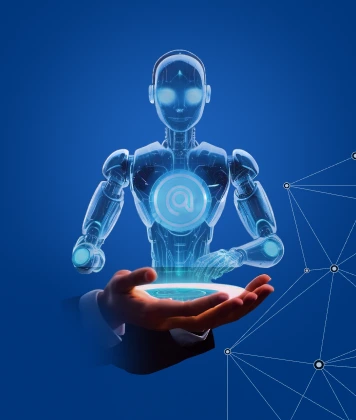As artificial intelligence continues to evolve at breakneck speed, its role in digital product development has become increasingly prominent. From automating tedious tasks to generating innovative ideas, AI is no longer just a support tool-it’s becoming a strategic collaborator. This shift has sparked a bold question for tech-forward teams: Can AI be used to build a product from zero to one-completely from scratch?
At TechLattice, we decided to put this idea to the test. As early adopters of emerging technologies, we set out on an ambitious journey: to ideate, design, develop, and launch a complete digital product using only AI tools. Every decision, every prototype, and every line of code was influenced or generated by AI. Through this unique experiment, we discovered the strengths and limits of current AI capabilities and uncovered valuable insights about what it means to create in the age of artificial intelligence.

Can AI Build a Product from Scratch?
As an early adopter of technology trends, TechLattice has been actively exploring how AI can reshape the product development process. Our curiosity led us to ask a bold question: “What if we relied solely on AI to ideate, design, and build a digital product?”
With this in mind, we launched an ambitious experiment-to create and launch an AI-native digital product by deferring to AI tools at every stage of the development lifecycle. Through this journey, we uncovered new platforms, streamlined processes, and gained a deep understanding of what today’s AI can truly accomplish in end-to-end product creation. Here’s what we discovered.
IDEATE: Business Strategy & Digital Product Management
The ideation stage is the cornerstone of any successful digital product. It's where vision and strategy converge to shape a viable business opportunity. In our AI-native journey, we began by exploring critical strategic questions: What problem are we solving? Is there a market fit? Can the product generate sustainable revenue? These questions framed our approach, allowing us to validate ideas against real-world user needs, business goals, and technological feasibility.
To supercharge our ideation phase, we leveraged a range of AI-powered platforms designed to accelerate and enhance the creative process. Tools like Stratup, Jeda AI, and Whimsical AI supported collaborative brainstorming, transforming vague concepts into clear product visions backed by data-driven insights. For structured product planning and roadmap development, platforms such as AI-enabled Trello, Catalist, Aha! AI, and Motion helped prioritize features, forecast delivery timelines, and allocate resources efficiently.
- Product Ideation: AI-driven brainstorming tools like Stratup, Jeda AI, and Whimsical AI foster collaboration and spark innovative ideas.
- Product Planning: AI-enabled Trello, Catalist, Aha! AI, and Motion aid in roadmap planning and task prioritization.
- Project Estimation: Tools such as Estimate AI and Peak.ai provide data-backed budgeting and risk assessment.
- Project Management: Asana AI, ClickUp Brain, and Monday AI streamline workflows and improve team efficiency through automation.
- Product Positioning: Platforms like Crayon and Mindspeller offer market intelligence to define and refine product strategy.
DESIGN: User Experience & Product Design
With a solid strategy in place, the design phase becomes the bridge between concept and execution. This is where ideas take form as user-centric, intuitive, and visually compelling experiences. In our AI-native approach, artificial intelligence tools enhanced the process-from user research to interface mockups-by automating repetitive tasks and accelerating creative exploration. Our design team collaborated closely with AI to ensure every element served both aesthetic and functional goals.
AI-assisted platforms supported everything from collecting user insights to crafting scalable design systems and interactive prototypes. Tools like DataRobot and Otter.ai elevated our user interview process, extracting actionable insights that directly influenced UX decisions. Miro AI and Dovetail allowed us to synthesize research data quickly, while Visily.ai and Components.ai helped standardize design components and catch potential usability issues early. Rapid prototyping tools such as Uizard, Canva Magic Design, and Mockplus enabled quick iteration, reducing the time to move from concept to clickable mockups.
- User Interviewing: DataRobot and Otter.ai analyze qualitative input and generate key insights to shape user-focused design.
- User Experience Research: Miro AI and Dovetail simplify data gathering and analysis, leading to well-informed design decisions.
- Design Systems: Visily.ai and Components.ai assist in building scalable design systems while identifying usability gaps and improvement opportunities.
- Interface Design: Uizard, Canva Magic Design, and Mockplus speed up wireframing and prototyping, reducing development cycles.
DEVELOP: Technology & Software Engineering
The development phase is where your product’s architecture comes to life. Leveraging AI-powered tools throughout this stage allowed us to streamline the entire software engineering process-from writing code to deployment. By combining AI capabilities with our development team’s technical expertise, we accelerated delivery, improved code quality, and maintained scalability across the solution. Whether automating repetitive tasks or offering real-time code suggestions, AI helped reduce complexity and enhance efficiency.
Our web application development process became faster and more effective with tools like GitHub CoPilot and Adobe Sensei, which assisted in both front-end and back-end tasks. For front-end automation, TeleportHQ and Builder AI transformed design files into responsive HTML, CSS, and JavaScript. Back-end development was enhanced by Tabnine and DeepCode AI (by Snyk), which helped with code suggestions, optimization, and database generation. Zapier and UiPath facilitated seamless system integration, while DevOps tasks like CI/CD and monitoring were efficiently managed using Harness.io and Azure AI.
- Web App Development: GitHub CoPilot and Adobe Sensei with Adobe Experience Cloud accelerate the development and design cycle.
- Front-End Development: TeleportHQ and Builder AI convert visual designs into production-ready HTML, CSS, and JavaScript code.
- Back-End Development: Tabnine and DeepCode AI (Snyk) aid in writing, debugging, and optimizing scalable server-side logic and data structures.
- System Integration: Zapier and UiPath use AI to connect and automate workflows across different platforms.
- DevOps: Harness.io and Azure AI automate deployment pipelines, infrastructure management, and performance monitoring.
TEST: Quality Assurance & Performance Validation

Before any product goes live, ensuring its reliability, performance, and user experience is critical. In this phase, we relied on AI-driven testing tools to identify bugs, validate functionality, and ensure everything worked seamlessly across devices and environments. The goal was clear-deliver a flawless experience to end users from day one.
Automated Functional Testing
Platforms like Testim.io and Functionize helped us automate regression and functional testing, allowing rapid validation of new features without manual overhead.
Visual & UI Testing
Using Applitools, we ensured visual consistency across browsers and screen sizes. It automatically flagged UI discrepancies, so we could maintain high design standards effortlessly.
Performance Monitoring
Real-time monitoring tools like New Relic AI and Datadog enabled proactive detection of bottlenecks, server load issues, and resource inefficiencies during stress testing.
Security & Compliance Testing
We used Darktrace and Snyk to detect vulnerabilities, enforce secure coding practices, and ensure compliance with GDPR, HIPAA, and other regulatory frameworks.
LAUNCH: Go-to-Market Strategy with AI Support
With testing complete and confidence in our product's performance, it was time to launch. This stage focused on creating compelling messaging, crafting a content strategy, and executing campaigns-all powered by AI. Our go-to-market approach was faster, smarter, and more precise thanks to intelligent automation.
Marketing Content & Copywriting
Tools like ChatGPT, Copy.ai, and Jasper helped us generate launch copy, email campaigns, ad headlines, and landing page content within hours.
SEO & Content Strategy
Using MarketMuse and SurferSEO, we crafted a content roadmap that aligned with high-intent keywords, boosting organic visibility from the start.
Campaign Automation & CRM
We deployed HubSpot AI and ActiveCampaign to automate lead nurturing, audience segmentation, and follow-ups, ensuring a consistent and personalized outreach experience.
The result? A smooth product launch backed by intelligent insights, high-quality content, and real-time adaptability-setting the stage for long-term adoption and market growth.
Conclusion
Building a digital product entirely with AI tools isn’t just a futuristic concept-it’s a present-day reality. From ideation and strategy to design, development, and deployment, artificial intelligence has evolved to play a critical role at every stage of the product lifecycle. While human creativity and oversight remain indispensable, AI significantly enhances speed, precision, and scalability.
Our experiment in going "AI-native" highlighted the powerful synergy between human innovation and machine intelligence. By thoughtfully integrating AI across the workflow, organizations can unlock faster go-to-market times, reduce operational overhead, and create more personalized user experiences. The key lies in knowing how to balance automation with human judgment.
The future of product development is collaborative-and AI is one of the most promising partners in that journey. If you're considering how to harness the power of AI in your next project, now is the time to start.
Ready to start your AI-powered product journey?
Work with us to design and build digital products that combine the best of human creativity and AI-driven efficiency.
Let's create smarter, faster, and more scalable solutions-together.



